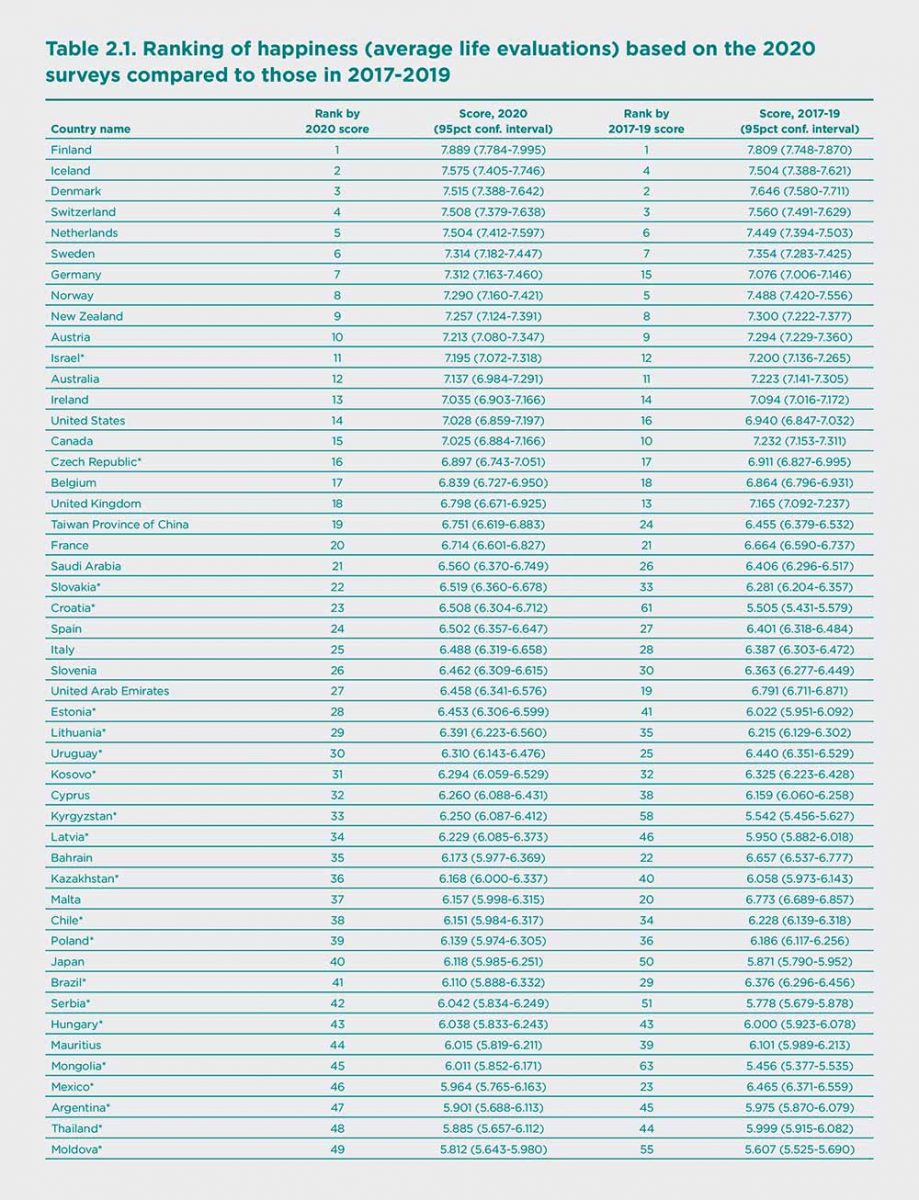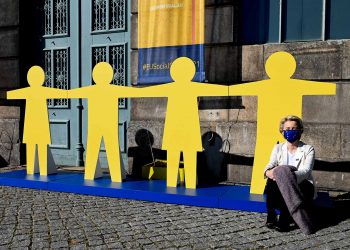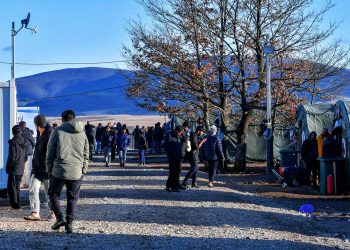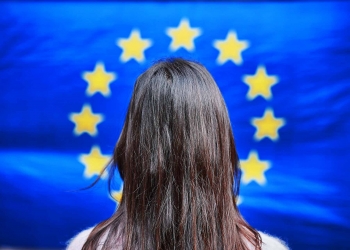For the fourth year in a row, Finland ranked happiest country in the world again, in an annual UN report. Why are Finns the happiest people in the world?
In observance of the U.N. International Day of Happiness on March 20, the Sustainable Development Solutions Network (SDSN), Center for Sustainable Development at Columbia University (CSD), and partners of the World Happiness Report (WHR) hosted the launch of the 2021 World Happiness Report. As we are living through an exceptional time dealing with the widespread effects of the pandemic, this year’s World Happiness Report discussed world happiness during COVID-19.
The World Happiness Report 2021 focuses on the effects of COVID-19 and how people all over the world have fared. World Happiness Report aim was two-fold, first to focus on the effects of COVID-19 on the structure and quality of people’s lives, and second to describe and evaluate how governments all over the world have dealt with the pandemic. In particular, World Happiness Report try to explain why some countries have done so much better than others.
Finland ranked happiest country in the world – again
Finland “ranked very high on the measures of mutual trust that have helped to protect lives and livelihoods during the pandemic”, the authors said. The Scandinavian country remains world’s happiest country for the 4th year in a row.
The Nordic country of 5.5 million population has managed far better than the majority of Europe during the pandemic. Despite the catastrophic effects of the COVID-19 pandemic in all areas of life, Finland is on TOP once again. This is the result according to the 2021 World Happiness Report, released the day before the International Day of Happiness. Finland had over 70,000 cases and 805 deaths, according to Johns Hopkins University.
According to the report, the ten happiest countries are:
COVID-19 has shaken happiness and lives everywhere
The report focuses primarily on the relationship between well-being and the pandemic. This ninth World Happiness Report is unlike any that have come before. COVID-19 has shaken, taken, and reshaped lives everywhere. In this chapter, the central purpose remains just what it has always been – to measure and use subjective well-being to track and explain the quality of lives all over the globe. The capacity to do this has been shaken at the same time as the lives World Happiness Reporters are struggling to assess. While still relying on the Gallup World Poll as the primary source for the measures of the quality of life, this year, World Happiness Report tap a broader variety of data to trace the size and distribution of the happiness impacts of COVID-19.
World Happiness Report also devotes equal efforts to unravelling how geography, demography, and the spread of the virus have interacted with each country’s scientific knowledge and social and political underpinnings. Εspecially their institutional and social trust levels explain international differences in death rates from COVID-19.
Global life evaluations have shown remarkable resilience in the face of COVID-19.
First a look at the primary data for 2020. The first column of Table 2.1 shows ranked orderings of average national life evaluations based on the 2020 surveys,. It is accompanied in the second column by a ranked list of the same countries based on the 2017-2019 surveys used for the national rankings in World Happiness Report 2020. From the 95% confidence regions shown for both series, it is easy to see that the bands are much wider for 2020. Primarily because the sample sizes are generally 1,000 in comparison to 3,000 for the sample covering 2017-2019.
Figure 2.1 combines the 2020 data with that from 2018 and 2019, just as done in a normal year. The figure covers 149 countries, because countries are included as long as they have had one or more surveys in the 2018-2020 averaging period. Country positions in all three rankings are quite similar. Comparing the first two rankings, where the number of countries is the same, the pairwise rank correlation is 0.92. Comparing the 2017-2019 rankings with those based on the 2018-2020 data, for the 95 countries with data for 2020, the rank correlation is 0.99. This shows that COVID-19 has led to only modest changes in the overall rankings. It reflected both the global nature of the pandemic and a widely shared resilience in the face of it.
Finland on TOP as the happiest country in the world
This has been a challenging year for the world, and for the preparation of the World Happiness Report. Millions of lives have been lost, and billions of others shaken to their core. COVID-19 has altered how people live. How they think about life, and even how surveys can focus to assess these consequences. Many strands of data came together to produce a picture of almost astonishing resilience. This general pattern shows up in a number of different large-sample surveys with different timing and sampling methods. World Happiness Reporters have some confidence that the pattern is there. Especially as the surveys taken more frequently match the pandemic stages and severity appropriately.

Top countries before the pandemic remained the top countries in 2020
Who are we most likely to be missing? The surveys employed to measure happiness cannot be taken within many of the hardest-hit groups. These groups include those living in elder-care, prisons, hospitals, refugee camps, and on the streets. But they can still represent the vast majority of the world’s population. In other words rich and poor, healthy and sick, employed and unemployed. People living in very supportive or very divided communities and countries. Although there were significant increases in average sadness and worry, World Happiness Report found that overall life evaluations, and happiness rankings, were surprising stable.
The top countries before the pandemic remained the top countries in 2020, so there is little change in the overall rankings. The top countries already had higher levels of trust and lower levels of inequality, both of which helped them to keep death rates low and social cohesion high, and hence to maintain their favourable positions.
The pandemic is still far from over
As World Happiness Report published to press in early March of 2021, the pandemic is still far from over. The conclusions about happiness during COVID-19 must remain tentative. World Happiness Report founds for 2020 that the same six factors supporting well-being (income, health, someone to count on, freedom, generosity, and trust) continue to do so in almost exactly the same way as in previous years. The measures of support have also been generally maintained. People were just as likely to have someone to count on, even though the ways in which this support is delivered have been upended. People have not toured the world, but many have rediscovered their neighbourhoods.
Respondents over 60 years of age were in 2020 significantly less likely than in earlier years to report having health problems, despite being the age group most at risk from COVID-19. They were also the group showing a significant increase in having someone to count on in times of trouble. At least for them, neighbours and Zoom calls were filling in for the face-to-face contacts being put on hold.
Finland the happiest country in the world for 2021
Finland holds the rank of the happiest country in the world for the fourth consecutive year according to the World Happiness Report. The Scandinavian country ranks very high on the measures of mutual trust.
Countries with experience from the SARS epidemic seemed to have absorbed the relevant lessons, as did countries with female leaders. Countries with less inequality of income also had significantly lower death rates from COVID-19. This is partly because high social trust tends to go along with less income inequality. The economically disadvantaged in many countries faced the greatest chances of illness and death from COVID-19. The countries that chose to control the pandemic showed no trade-off between a healthy economy and a healthy population. On average, those countries with lower deaths rates had lower drops or bigger gains in expected 2020 growth rates for GDP (r=-.36). In 2021, the advantages of virus control look to be even larger, as many of the less controlled countries are still facing high case counts and death rates coupled with deep restrictions on economic and social life.
World Happiness Report
The World Happiness Report is a publication of the Sustainable Development Solutions Network, powered by data from the Gallup World Poll and Lloyd’s Register Foundation. They both provided access to the World Risk Poll. The 2021 Report includes data from the ICL-YouGov Behaviour Tracker . This is part of the COVID Data Hub from the Institute of Global Health Innovation.
The Report is supported by The Ernesto Illy Foundation, illycaffè, Davines Group, The Blue Chip Foundation, The William, Jeff, and Jennifer Gross Family Foundation, The Happier Way Foundation, Indeed, and Unilever’s largest ice cream brand, Wall’s.
The World Happiness Report was written by a group of independent experts acting in their personal capacities. Any views expressed in this report do not necessarily reflect the views of any organization, agency or program of the United Nations.
















